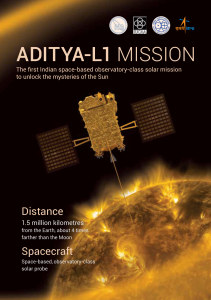NEW DELHI & MELBOURNE, September 2: After the recent successful Chandryaan-3 Moon mission, India today launched its big bang into space, its Polar Satellite Launch Vehicle (PSLV-C57) Aditya-L1 spacecraft, from the Second Launch Pad of Satish Dhawan Space Centre (SDSC), Sriharikota, Andhra Pradesh. The Aditya-L1 is likely increase India’s footprint in space, with many other ambitious projects including the upcoming Gaganyaan mission to the Moon.
Somak Raychaudhury who was involved in the development of certain parts of the mission’s observatory said that Aditya-L1 had the capacity to make a “big bang in terms of science’, reports dw.com. Raychaudhury told NDTV that one of the main things the probe will study are coronal mass ejections, a periodic phenomenon which sees massive discharges of plasma and magnetic energy from the Sun’s atmosphere.

After a flight duration of 63 minutes and 20 seconds, Aditya-L1 spacecraft successfully injected into an elliptical orbit of 235×19500 km around the Earth.Aditya-L1 is the first Indian space based observatory to study the Sun from a halo orbit around first Sun-Earth Lagrangian point (L1), which is located roughly 1.5 million km from earth. It will undergo four earth-bound orbital manoeuvres before placing in the transfer orbit towards the Lagrange point L1. Aditya-L1 is expected to arrive the intended orbit at the L1 point after about 127 days.
Aditya-L1 carries seven scientific payloads indigenously developed by ISRO and national research laboratories including Indian Institute of Astrophysics (IIA), Bengaluru and Inter University Centre for Astronomy & Astrophysics (IUCAA), Pune.
ANI adds: The Aditya-L1 mission is expected to reach the observation point in four months. It will be placed in a halo orbit around Lagrangian Point 1 (or L1), which is 1.5 million km away from the Earth in the direction of the sun.

It is carrying seven different payloads to conduct a detailed study of the sun, four of which will observe the light from the sun and the other three will measure in-situ parameters of the plasma and magnetic fields.
The largest and technically most challenging payload on Aditya-L1 is the Visible Emission Line Coronagraph or VELC. VELC was integrated, tested, and calibrated at the Indian Institute of Astrophysics’ CREST (Centre for Research and Education in Science Technology) campus in Hosakote in collaboration with ISRO.
This strategic location will enable Aditya-L1 to continuously observe the sun without being hindered by eclipses or occultation, allowing scientists to study solar activities and their impact on space weather in real-time.
Also, the spacecraft’s data will help identify the sequence of processes that lead to solar eruptive events and contribute to a deeper understanding of space weather drivers.
Major objectives of India’s solar mission include the study of the physics of solar corona and its heating mechanism, the solar wind acceleration, coupling and dynamics of the solar atmosphere, solar wind distribution and temperature anisotropy, and origin of Coronal Mass Ejections (CME) and flares and near-earth space weather.
According to the Bengaluru-based Indian Institute of Astrophysics, the atmosphere of the sun, the corona, is what is seen during a total solar eclipse. A coronagraph like the VELC is an instrument that cuts out the light from the disk of the Sun and can thus image the much fainter corona at all times.
Addressing scientists at ISRO to cheers and claps after the successful launch — Aditya L1 — Nigar Shaji, the director of the project, said it was like a dream coming true.
Talking to ANI, Shaji said, “It feels like a dream coming true. I am extremely happy that Aditya L-1 has been injected successfully (into the designated orbit) by the PSLV. Aditya L-1 has successfully embarked on its 125-day journey.”
India’s Prime Minister Narendra Modi, Home Minister Amit Shah, and Congress President Malikarjun Kharge, among other leaders, congratulated the ISRO scientists for the successful launch of Aditya-L1.



